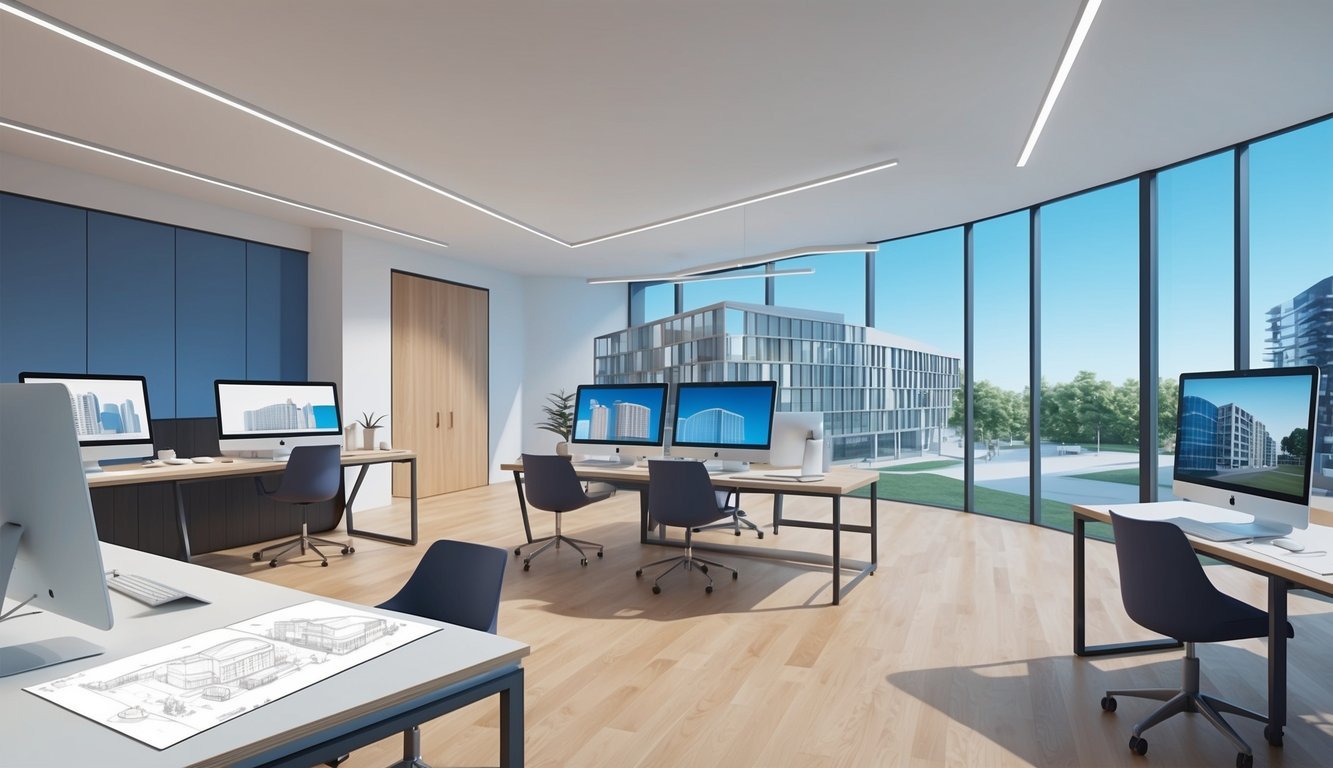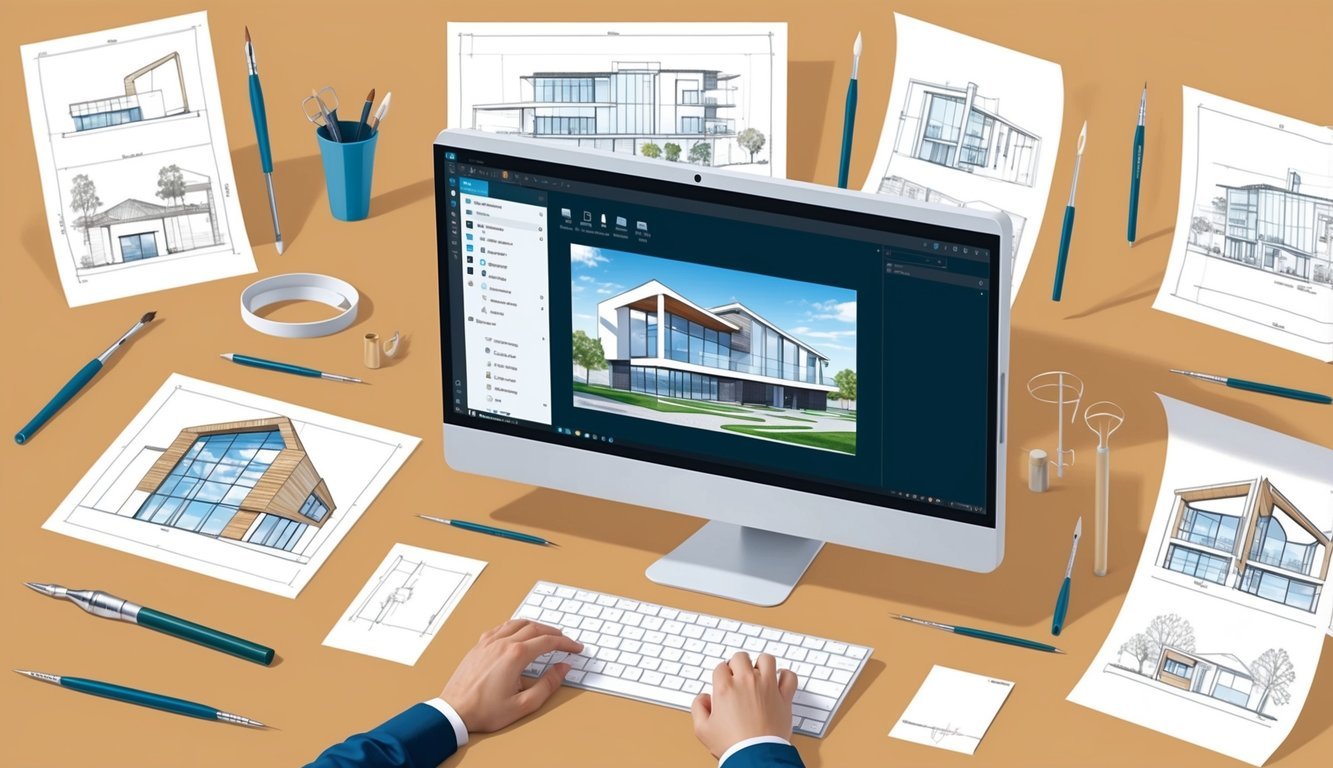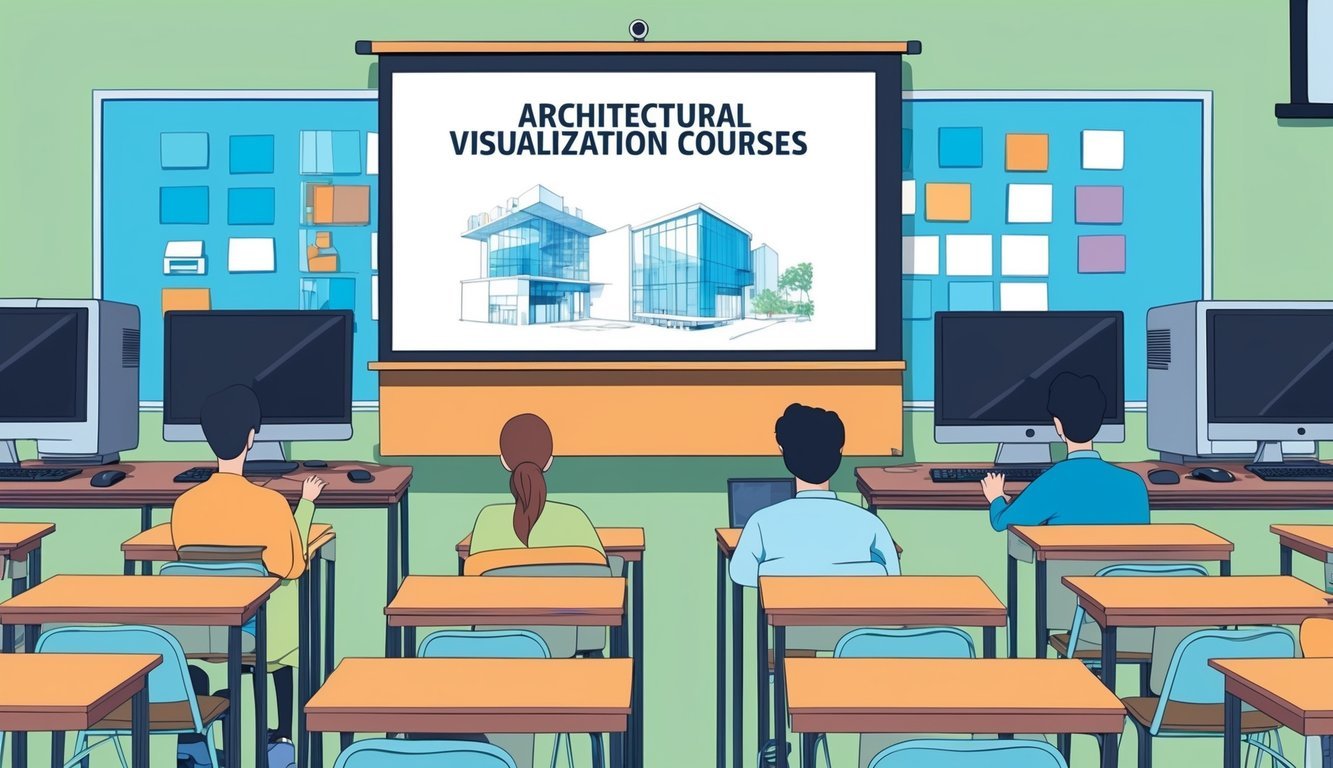Ever found yourself dreaming about turning your building designs into breathtaking visuals? If so, architectural visualization courses are just what you need! These courses can teach you how to create jaw-dropping 3D renderings of buildings and spaces, whether you’re an architect, designer, or simply someone with a passion for digital art.
Trust me, these skills are more valuable than you might think!

Embarking on the journey of architectural visualization can unlock a world of job opportunities.
Picture yourself working on fascinating projects like designing video game environments, crafting virtual reality experiences, or even creating 3D animations for films.
The best courses will arm you with industry-standard software and techniques that pros rely on.
With a bit of practice, you’ll be turning simple blueprints into stunning photorealistic images in no time.
1) Mastering Architecture Visualization on Udemy
Ready to create some eye-catching 3D designs? Check out Udemy’s fantastic courses to boost your architectural visualization skills.
One of the best is the 3ds Max Architectural Visualization Masterclass.
It’ll take you from novice to pro in no time, teaching you how to tweak the software and master advanced modeling techniques.
If Blender is more your style, the Complete Blender Interior 3D Modelling & Rendering course has got you covered.
You’ll journey through everything from 3D modeling basics to lighting and rendering, and you’ll be whipping up photo-realistic interior scenes in a snap.
And for those looking to expand their Blender skills even further, the Architectural Visualization with Blender course is a winner.
It’s great for both newbies and seasoned pros, helping you transform architectural designs into mesmerizing visuals.
All these courses provide hands-on practice with tools that the industry swears by.
You’ll be picking up practical skills you can apply immediately, plus Udemy often has sales, so you might snag a course for a steal!
2) Introduction to Architectural Visualization at Coursera

Hey! Thinking about jumping headfirst into architectural visualization? Coursera has some solid options that could be just what you need.
The courses here cover a broad spectrum of topics, from basic design principles to advanced 3D modeling techniques.
A standout is the Introduction to Architectural Visualization, which is perfect for beginners.
You’ll get to grips with the fundamentals of creating stunning visual representations of buildings and spaces.
This course offers hands-on experience with the popular software tools used in the industry.
Plus, you’ll learn how to breathe life into your designs through realistic renderings and animations.
The best part? You can learn at your own pace.
Coursera’s flexible schedule is a lifesaver for those of us with busy lives.
By the time you finish, you’ll have a solid foundation in architectural visualization, ready to take on more advanced topics or start bringing your own spectacular designs to life.
3) The Gnomon Workshop – Architectural Rendering

The Gnomon Workshop is a fantastic resource for learning some seriously cool architectural rendering skills.
They’ve got a variety of courses that can help you enhance your abilities.
Check out Design Futuristic Architecture Using Blender if you’re into creating sci-fi-inspired buildings.
This course covers everything from modeling to texturing and landscape design.
And if you want to nail that realistic look, their 3ds Max: Advanced Lighting course will teach you top-notch lighting techniques to make your renders pop.
What sets The Gnomon Workshop apart? They bring in professional artists to share their knowledge.
You’ll be learning from folks who’ve worked in major studios and have loads of real-world experience.
Their courses dive into a range of software like Blender, 3ds Max, and Photoshop.
No matter your tool of choice, you’re bound to find something that clicks.
4) 3D Architectural Visualization Basics on Skillshare

If you’re just dipping your toes into architectural visualization, Skillshare is a great place to start with some beginner-friendly courses.
You might want to try the D5 Render 2.5 and Beyond course, which shows you the ropes of using D5 Render to bring your designs to life with amazing detail.
Another fantastic option is the D5 Render 3D rendering course.
This one teaches you how to whip up beautiful 3D renderings and 360 presentations in no time.
If you’re into gaming, check out the Unreal Engine 5 course.
It covers the essentials of materials, which are super important in architectural visualization.
These courses are perfect for rookies.
They’ll guide you through the basics of 3D rendering and help you create stunning visuals.
Plus, some of the best online landscape design courses cover outdoor environments too, so you can design those picture-perfect gardens and parks.
Trust me, with these skills, you’ll be creating professional-quality renders in no time!
What to Look For in a Course

When you’re on the hunt for an architectural visualization course, think about the skills you want to learn and the software they’ll teach you.
These factors will seriously impact how well you learn and your future career options.
Essential Skills Covered
Search for courses that teach the core techniques of visualization.
You’ll want to master 3D modeling, rendering, and animation since these really bring designs to life.
Lighting and texturing are also key components.
They add that much-needed realism to your work.
Some courses might even touch on advanced topics like VR and AR, which could give you that extra edge in the job market.
Don’t forget about composition and storytelling! These elements help make your visuals more engaging.
Check if the course covers how to present your projects professionally—trust me, that’s a game changer.
Software and Tools Used
The software covered in a course can make a huge difference in your learning.
Think about popular programs like 3ds Max, V-Ray, and Rhino.
Make sure the course includes software that’s widely used in the industry.
Some courses might focus on multiple programs, which can be great for versatility, while others may zero in on mastering one tool in depth.
Balance is key!
Look for courses that provide hands-on practice.
Getting your hands dirty will help you learn way faster.
Some even offer student licenses for the software, which is a bonus!
It’s worth considering if the course includes any plugins or scripts.
They can speed up your workflow, which is always a plus, and check for free or open-source alternatives while you’re at it.
Tips for Success in Visualization Courses

Ready to ace your architectural visualization course? Here are some tips to help you crush it:
Practice makes perfect! The more you tinker around with the software, the better you’ll get.
Try to carve out some time each day to work on your skills.
Don’t hesitate to ask questions! Your instructors are there to help, so if something isn’t clicking, speak up.
Team up with your classmates! Collaborating can help you learn faster and make the whole process more fun.
Keep an inspiration folder.
Collect cool images and designs that catch your eye; they’ll come in handy for your projects.
Stay updated on software changes.
The tech world moves quickly, so you want to keep up with the latest tools.
And don’t forget to take breaks! Staring at a screen can be draining—get up and stretch, then come back refreshed.
Build an awesome portfolio as you go.
Save your best work to showcase later—trust me, it’ll pay off!
Remember, mistakes are just stepping stones to learning.
Don’t stress if your work isn’t perfect at first.
Most importantly, have fun! Visualization is all about creativity, so let your imagination run wild.
Frequently Asked Questions

Curious about architectural visualization? It’s a growing field with tons of opportunities.
Let’s go through some common questions about courses, skills, and career options.
What are some recommended online courses for learning architectural visualization?
You might want to kick things off with Mastering Architecture Visualization on Udemy.
It’s fantastic for beginners while covering essential software tools.
Another solid pick is the Introduction to Architectural Visualization on Coursera—it lays a great foundation in 3D modeling and rendering.
Are there any free courses available to boost my architectural rendering skills?
You bet! There are plenty of free tutorials on YouTube covering specific techniques.
They’re a fantastic way to improve your skills without spending a dime.
Plus, some paid platforms like Skillshare even offer free trials, giving you a chance to learn a lot during that time.
Which certification programs are considered the best for architectural visualization?
The Gnomon Workshop offers respected certificates in architectural rendering, known for their high-quality content.
You can also check out LinkedIn Learning, which provides certificates upon completion of their ArchViz courses—definitely a nice touch for your resume!
How can I kickstart a career in 3D architectural visualization?
Start by building a strong portfolio that showcases your best work.
Keep practicing and learning new techniques.
Network with professionals in the field.
Join online forums and try to attend industry events when you can!
What software should I focus on for professional architectural rendering?
Get comfy with 3D modeling software like SketchUp or Rhino, and for rendering, you’ll want to master programs like V-Ray or Corona Renderer.
Post-processing tools like Photoshop are also crucial for those final touches on your renders.
What’s the typical salary for someone working in 3D architectural visualization?
Salaries can vary widely based on experience and location.
Entry-level positions usually start around $40,000-$50,000 a year, but experienced pros can earn $70,000-$100,000 or even more, especially in big cities or top firms.

